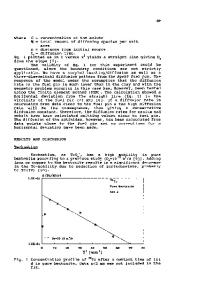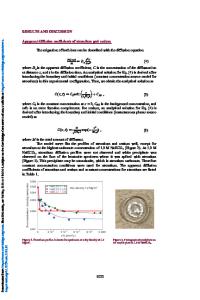Migration Behavior of Copper in Compacted Bentonite Using Electromigration Techniques
- PDF / 1,559,228 Bytes
- 7 Pages / 432 x 648 pts Page_size
- 75 Downloads / 297 Views
MRS Advances © 2020 Materials Research Society DOI: 10.1557/adv.2020.55
Migration Behavior of Copper in Compacted Bentonite Using Electromigration Techniques Kazuya Idemitsu, Keisuke Yoshida, Yaohiro Inagaki, Tatsumi Arima Dept. of Applied Quantum Physics and Nuclear Engineering, Kyushu Univ., 744 Motooka, Nishi-ku, Fukuoka, Japan
ABSTRACT
Copper is a candidate for use as an overpack material in deep underground nuclear waste disposal. Copper, however, is susceptible to corrosion following closure of the repository and migration of the corrosion products through the buffer material may affect the migration of redox-sensitive radionuclides. Electromigration experiments were performed whereby a copper coupon, which was in contact with compacted bentonite, served as the working electrode and was held at a constant potential of between +100 to +400 mV vs. Ag/AgCl electrode for up to 48 h. The amounts of copper that migrated into the bentonite specimens were found to be in good agreement with the calculated values based on the corrosion current flow for the assumption that copper underwent anodic dissolution as Cu(II). A model based on dispersion and electromigration was able to explain the measured copper profiles in the bentonite specimens. The fitted values of the dispersion coefficient did not depend on the applied potential and were about 10-12 m2/s.
INTRODUCTION Copper is a candidate material for overpack in high-level radioactive waste disposal [1]. Copper is relatively resistant to corrosion compared with carbon steels in typical ground water exposure scenarios. In the case of carbon steel overpack, ferrous ions diffuse into the buffer material such that a reducing environment is maintained in the vicinity of the repository. As a result, the reducing conditions would be expected to modify the migration behavior of redox-sensitive radionuclides [2]. The corrosion potential of copper is higher than that of carbon steel, so the corrosion products of copper may not affect the migration behavior of redox-sensitive radionuclides such as plutonium to the same extent as those of carbon steel. Recently, our research group demonstrated the migration of plutonium in bentonite (movement of ~2 mm in bentonite within one week) using electromigration techniques [3-5]. The results showed that plutonium
Downloaded from https://www.cambridge.org/core. Lund University Libraries, on 10 Feb 2020 at 06:56:47, subject to the Cambridge Core terms of use, available at https://www.cambridge.org/core/terms. https://doi.org/10.1557/adv.2020.55
exhibited a higher diffusion coefficient under reducing and low pH conditions in bentonite in the presence of iron corrosion products relative to that under oxidizing conditions. The corrosion potential of copper is higher than that of iron. Moreover, the copper corrosion products would not be expected to lower the pH of pore water in bentonite compared with iron corrosion products. This study aims to clarify the electromigration behavior of copper in compacted bentonite through experiments us
Data Loading...











